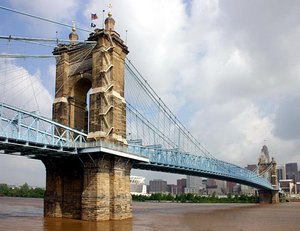John A. Roebling Suspension Bridge
|
|

The John A. Roebling Suspension Bridge spans the Ohio River between Cincinnati, Ohio and Covington, Kentucky. When the first pedestrians crossed on December 1, 1866, it was the longest suspension bridge in the world at 1,057 feet (322 m).
| Contents |
Filling a need
By the mid-1800s, Cincinnati had become the nation's leading inland port, and ferry traffic to and from Covington and Newport, Kentucky was at a level where the need for a bridge was apparent. The Covington-Cincinnati Bridge Company, led by Covington businessman Amos Shinkle, was formed to oversee the project. The state of Ohio mandated, however, that if a span was to be built, the piers could not interfere with the city's river shipping, and the deck would have to be high enough for the stacks of steamboats to pass underneath. The 1849 charter for the bridge required:
- no piers in the river
- a length of 1,400 feet and,
- a deck clearance of 112 feet.
No such bridge had ever been built, but engineer John August Roebling submitted a design and was awarded the job. By the time construction started in 1856, a new charter had eased the specifications for the bridge, shortening the required length to 1,000 feet and height to 100 feet.
Cincinnati-roebling-suspension-bridge.jpg
Engineering achievement
Construction continued for over ten years, interrupted by financial shortages and the Civil War, during which the city and the unfinished bridge were under threat of attack. The bridge was completed in December, 1866. As the first bridge to use both vertical suspenders and diagonal stays fanning from each of its 230-foot stone towers, it served as the prototype for Roebling's design of the Brooklyn Bridge, which exceeded the Cincinnati bridge in length when it opened in New York in 1883.
When the Roebling Bridge was formally opened on January 1, 1867, the driver of a horse and buggy was charged a toll of 15 cents to cross; the toll for three horses and a carriage was 25 cents. Pedestrians were charged a penny.
Alterations and designations
The original deck of the bridge was built at the lowest possible cost due to Civil War inflation, but the stone towers were designed to carry a much heavier load than was originally demanded. In 1896, the bridge was painted blue (rather than brown) and received a second set of main cables, a wider steel deck, and a longer northern approach. The reconstruction significantly altered the appearance of the bridge, but the new 30-ton weight limit extended its usefulness through the 20th century and beyond.
The Covington-Cincinnati Bridge Company--a private company--operated the bridge until the Commonwealth of Kentucky purchased it in 1953 for $4.2 million. The state collected tolls until 1963 when the Brent Spence Bridge was opened downriver on Interstate 75.
The bridge was listed on the National Register of Historic Places in 1975 and designated a National Historic Civil Engineering Landmark in 1983. It remains the busiest of Cincinnati's three non-expressway automobile or pedestrian bridges. Initially called the "Covington-Cincinnati Suspension Bridge," it was renamed in honor of its designer and builder on June 27, 1983.
See also
References
- The Suspension Bridge (http://www.cincinnati-transit.net/suspension.html). Cincinnati Transit.
- Bridging the century (http://www.cincypost.com/living/1999/bridge032599.html). The Cincinnati Post. March 25, 1999.
- John A. Roebling Suspension Bridge (http://www.rootsweb.com/~kycampbe/roeblinghistory.htm). RootsWeb.com.
External links
- Cincinnati by twilight (http://www.tysto.com/articles05/q2/20050407twilight.shtml) pictorial at Tysto.
- Aerial photo of bridge, from Microsoft Terraserver (http://terraserver-usa.com/usgsentry.aspx?T=1&S=10&Z=16&X=3576&Y=21649&W=3&qs=%7cCovington%7cky%7c)
